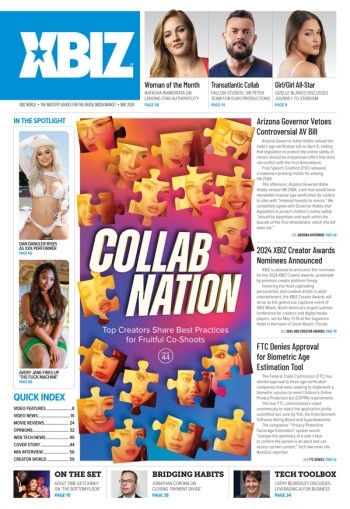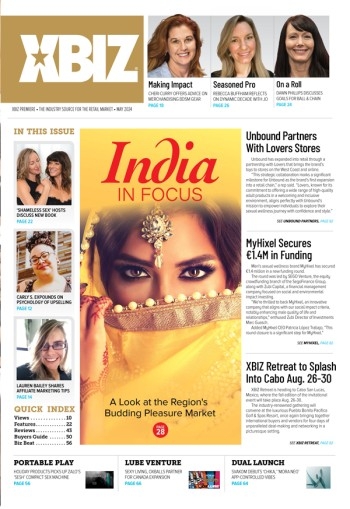Choosing a name to act as a trademark for your company’s new pleasure product or lube is an important decision. There are so many things to balance like the way the mark looks, the way it sounds, the marketability, the meaning … and the likelihood it is legally available and protectable. That last factor is one that sometimes gets “lost in the fray,” as they say. In an increasingly crowded market, decision-makers should understand the elements that go into availability and protectability. The importance of this is even greater now in the U.S. after a recent Supreme Court decision.
On April 23 of this year, the highest court in the land issued its decision in Romag Fasteners, Inc. v. Fossil Group, Inc. According to the opinion, the plaintiff in a trademark infringement suit does not have to prove a defendant’s infringement was "willful" as a prerequisite for an award of profits. This means that if a defendant is found guilty, the court could force it to hand over any profits it made, using the mark, to the plaintiff — regardless of whether the infringement was intentional.
The defense of 'I didn’t know' of the existence of the trademark is not an excuse for an infringer to be able to keep its wrongfully made profits.
Therefore, the defense of “I didn’t know” of the existence of the trademark is not an excuse for an infringer to be able to keep its wrongfully made profits. Accordingly, companies must use extreme caution in choosing trademarks for their products so as to avoid accidentally infringing on a third party’s mark, or risk losing all profits made under that mark in a lawsuit in addition to, of course, having to change the name.
Changing a product name, and beginning all over again, is like losing everything in a divorce. It’s expensive, painful and frustrating. So, just like you date someone before you commit to marriage, do your due diligence before committing to a trademark.
A foundation for that due diligence is understanding the five-point spectrum for evaluation of strength of trademarks. The “stronger” your trademark, the less likely you are to run into an overlap with a competitor, and the more likely it is to be available, and therefore, registerable for protection at the U.S. Patent & Trademark Office (or another country’s intellectual property office). I’ll go through some examples, but will not use adult industry brands so as to not “name names,” so to speak.
The strongest marks are “fanciful.” They have no meaning in English or another language. They are essentially a made-up term. These marks don’t suggest or describe anything about the goods or services that they designate. Examples are Exxon for gasoline or Pepsi for soft drinks.
Right under fanciful, in terms of strength, are arbitrary marks. They have a meaning in a language, but not in relation to the goods or services. Examples are Camel for cigarettes and Apple for computers.
In the middle of the spectrum are suggestive marks. Those suggest something about an aspect of the goods or services. An example is Dri-Foot, which was held suggestive for anti-perspirant deodorant.
Fanciful, arbitrary and suggestive marks are generally protectable (so long as someone else doesn’t have priority, which we’ll get to soon here). As we move down the spectrum, things get more hairy. Descriptive marks describe an aspect of the goods or services. Descriptive marks are protectable in some, but not all circumstances (beyond the scope of this article). An example of a mark held “merely descriptive” is Coaster-Cards for a coaster suitable for direct mailing.
Finally, at the bottom of the spectrum are generic marks. These are not really trademarks, but instead, words that directly name the goods or services to which they apply, and therefore, they are not protectable. For example, one could not trademark Apple for apples because then no one else would be able to call an apple fruit by its linguistic name without infringing on the trademark. Same thing for a vibrator — naming a vibrator “Vibrator” would not work out well.
The stronger the trademark, the more expensive and difficult it can be to brand it into the minds of consumers. A suggestive or descriptive mark is easier for a consumer to bring the product to mind so it requires less effort in branding, however, that also makes more companies want to use such a mark. Adopting a weaker mark means more chances of “stepping on toes” of those who have “priority” in the mark over you.
Priority indicates rights in a trademark, which can be acquired through either being: The first to use the mark as an identifier of particular goods; or the first to file an intent-to-use application at the USPTO for registration of a mark for the particular goods.
In reality, determining priority can be more complicated than that, but in a nutshell, it’s a ”first come, first served” system in the U.S. The first in line has rights over the others behind. If someone has priority in a mark for certain products, then the mark is not available to others for use on the same or similar products.
To determine whether someone else might have priority in a trademark, a search can be conducted. This can be done by a trademark attorney, or on your own. A search requires a reviewing of USPTO records (if you’re going to be selling in the U.S.) to look for marks that were previously registered or applied for, as well an exploration of the internet and other sources for marks that are in use but not registered, i.e. “unregistered” trademarks. The results can help you avoid picking an unavailable mark, i.e. one that is the same as or confusingly similar to a trademark in which a third party has priority. Choosing a mark in which someone else has priority could lead down the path of costly infringement litigation.
So, when choosing a mark, look at where it falls on the spectrum. Do your research. Find out who else is using a mark that might be similar to the one you’ve chosen. Evaluate whether confusion would be likely. Then decide whether it is worth the risk, if any, or if you should alter the mark or choose a different one.
Again, just like marriage is a commitment to an unknown, the road after choosing a trademark may be unknown. Surprises might happen, but you do your best to prevent them by vetting. A divorce from a trademark can be difficult, long and costly, just like that from a person. Choose well…
Disclaimer: The content of this article constitutes general information, and is not legal advice. If you would like legal advice from Maxine Lynn, an attorney-client relationship must be formed by signing a letter of engagement with her law firm. To inquire, visit Sextech.Lawyer.
Maxine Lynn is an intellectual property (IP) attorney with the law firm of Keohane & D’Alessandro, PLLC. She focuses her practice on prosecution of patents for sex technology, trademarks for business brands, and copyrights for creative materials.







